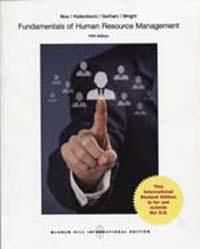1.Completely updated to reflect new trends, statistics, data, processes, and discussion in human resource management.
2.New!Chapter features throughout the Fifth Edition:
.HRM Social: Expanding on the importance of technology, these boxes demonstrate how social media and the Internet can be useful in managing HR activities in any organization;
.Experience HR: These experiential exercises encourage students to explore real-world HR topics and situations in both individual and group settings; and
.Twitter Focus: Linking students to online business cases that reinforce chapter content, this activity offers students the opportunity to use social media to connect with each other and discuss HR strategies via Twitter.
3.New HR topic sections throughout, such as, competency models in Chapter 4; the impact of online job applications in Chapter 6; employee engagement in Chapter 10; and the importance of brand alignment and integral part HR plays in this process in Chapter 16.
4.Fundamentals of Human Resource Management has an approach to teaching human resource management that involves engaging students in learning through the use of real-world examples and best practices; focusing them on important HR issues and concepts; and applying what they have learned through chapter features and end-of-chapter exercises and cases . As a result, students will be able to take what they have learned in the course and apply it to solving HRM problems they will encounter on the job.
5.A mix of pedagogical chapter features throughout the book that keep students engaged:
.Thinking Ethically – At the end of the chapters students are confronted with ethical issues regarding managing human resources and are asked to make decisions and justify their approach. Reviewers highlighted this feature because of its focus on critical thinking.
.HRM Oops! Boxes – Engage students through examples of companies whose HR department has missed the mark. Discussion questions at the end of each example encourage student analysis of the situation.
.Best Practices – Engage students through examples of companies whose HR department is working well. These real-world examples illustrate company policies that have been successfully put in place and help students apply chapter concepts to real-world business practices.
.Did You Know?Boxes – Engage students through interesting statistics related to HR topics and snapshots of real-world business practices.
6.End-of-chapter cases that focus on corporate sustainability (“Taking Responsibility”) and managing the workforce (“Managing Talent”).
作者簡介
Raymond A. Noe
現職:The Ohio State University
John R. Hollenbeck
現職:Michigan State University
Barry Gerhart
現職:University of Wisconsin
Patrick M. Wright
現職:University of South Carolina












